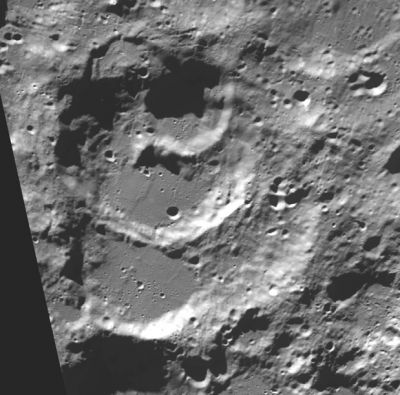Newton
Contents
Newton
|
Lat: 76.7°S, Long: 16.9°W, Diam: 78 km, Depth: 5.54 km, [/R%C3%BCkl%2073 Rükl: 73] |
Table of Contents
[#Newton Newton]
[#Newton-Images Images]
[#Newton-Maps Maps]
[#Newton-Description Description]
[#Newton-Description: Elger Description: Elger]
[#Newton-Description: Wikipedia Description: Wikipedia]
[#Newton-Additional Information Additional Information]
[#Newton-Nomenclature Nomenclature]
[#Newton-LPOD Articles LPOD Articles]
[#Newton-Bibliography Bibliography]
[#Newton-Certain Newtons in the Sourcebook Project (William R. Corliss) Certain Newtons in the Sourcebook Project (William R. Corliss)]

Clementine In this complicated cluster of craters Newton is the moderate sized circular crater near the top with a small peak at its center. It overlays smooth-floored 67-km Newton G on the south; and is overlain by Newton D, the 37-km circular crater inside the northeast rim. 64-km Newton A completes the line of large overlapping craters visible from Earth. It is cut off at the bottom of this image, with just the shadowed inner wall of its north rim showing. The little half-moon scallop on Newton's northwest rim is unnamed; nor does the broad bumpy extension to Newton's southeast appear to be part of any named crater.
Images
LPOD Photo Gallery Lunar Orbiter Images
Maps
([/LAC%20zone LAC zone] 137D3) USGS Digital Atlas PDF
Description
Description: Elger
([/IAU%20Directions IAU Directions]) NEWTON.--Is situated on the S.W. side of [/Short Short], and is the deepest walled-plain on the visible surface. It is of irregular form and about 143 miles in extreme length. One gigantic peak on the W. rises to nearly 24,000 feet above the floor, the greater part of which is always immersed in shadow, so that neither the earth or sun can at any time be seen from it.
Description: Wikipedia
Additional Information
- Depth data from [/Kurt%20Fisher%20crater%20depths Kurt Fisher database]
- Westfall, 2000: 5.54 km
- Viscardy, 1985: 8 km
- Cherrington, 1969: 6.49 km
- Elger was correct about the high rim and he even had the number about right, but the high points seem to be on the east, rather than the west. The shadows in LO-IV-130H2 show two points on the east rim (one to the north and one to the south), where the elevation is roughly 7,500 m (24,600 ft) relative to the floor. Similar, or even taller, rim peaks can be found in [/Amundsen Amundsen], [/Scott Scott], [/Zeeman Zeeman], and probably in several other craters as well. The central peak in Newton rises about 1,900 m above the floor. - JimMosher JimMosher
Nomenclature
- Named for Sir Isaac Newton (4 January 1643 – 31 March 1727), an English physicist, mathematician, astronomer, natural philosopher, and alchemist, regarded by many as the greatest figure in the history of science. His treatise Philosophiae Naturalis Principia Mathematica, published in 1687, described universal gravitation and the three laws of motion, laying the groundwork for classical mechanics.
- Although it has always had the present meaning in the [/IAU%20nomenclature IAU nomenclature], according to Elger, the name "Newton" was used by [/Johann%20Schr%C3%B6ter Schröter] to refer to a large buried crater just south of [/Plato Plato] which he believed to exist in [/Mare%20Imbrium Mare Imbrium] with [/Mons%20Pico Mons Pico] (and its associates) marking high points of the rim. See Elger's description of [/Plato Plato]. [/Beer%20and%20M%C3%A4dler Beer and Mädler] apparently thought that crater unworthy of so great a scientist, and moved the name to its present location. - JimMosher JimMosher
- Schröter's feature south of [/Plato Plato] has long been informally referred to as [/Ancient%20Newton Ancient Newton].- tychocrater tychocrater Aug 16, 2008
LPOD Articles
The Bottom of the World, Upside Down.
Mountains Near the South Pole.
Sliced in Half
Ring Eclipse
On Top of the World
What's in a Name?
Bibliography
- Harold Hill. [/A%20Portfolio%20of%20Lunar%20Drawings A Portfolio of Lunar Drawings], pages XXII, XXIII (how to draw a near-the-limb formation during different librations).
Certain Newtons in the Sourcebook Project (William R. Corliss)
- In Mysterious Universe, a handbook of astronomical anomalies (1979) :
- Page 190: Fingers of Light during Lunar Eclipse (T.H.Davies, Marine Observer, 1964). Note: in this article, a certain K.Newton is mentioned (who was a 2nd Officer aboard a ship which was (or could have been) known as Canopic) (?).
- Page 233: Was the Formation of a 20-km Diameter Impact Crater on the Moon Observed on June 18, 1178? (Jack B. Hartung, Meteoritics, 1976).
This page has been edited 1 times. The last modification was made by - tychocrater tychocrater on Jun 13, 2009 3:24 pm - afx3u2